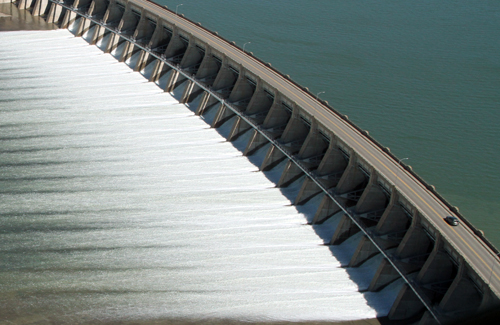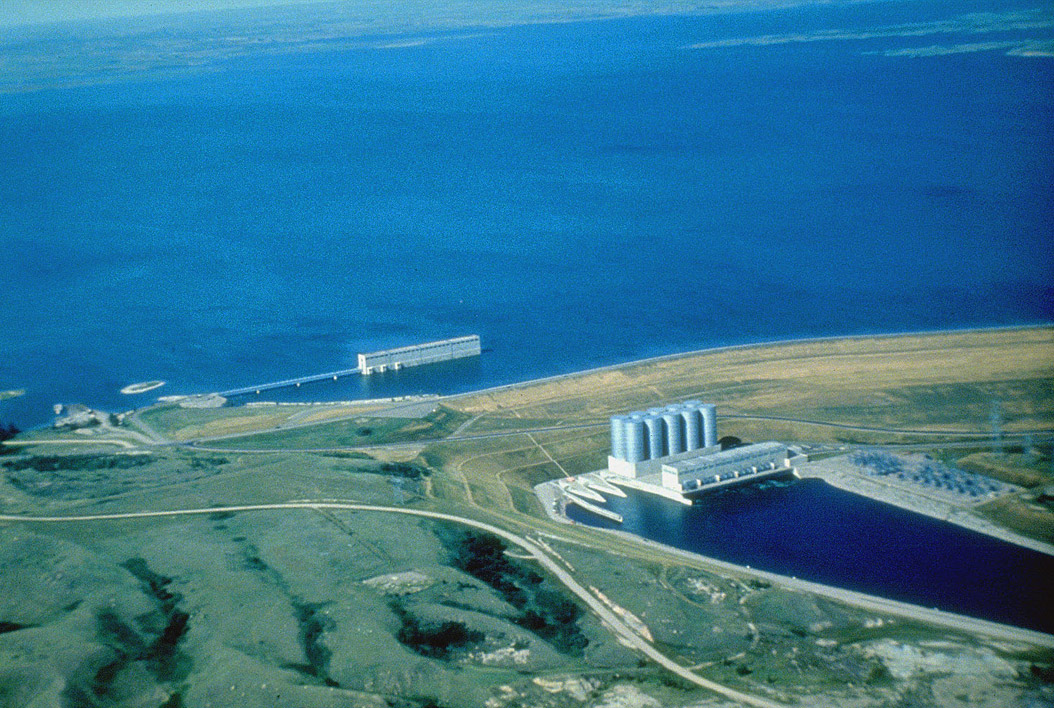What hydropower is:
- HydropowerHydro (HI-dro) means "water." is power created by changing the energy of moving water into a useful form of energy.
- Hydropower is a renewable resource because it will never be used up.
How hydropower is produced:
- As gravity pulls water from a high place to a low place, potentialPotential energy is energy at rest (stored energy). energy is changed to kineticKinetic energy is energy in motion. energy.
- BSC Energy Resource Tool: Visit the Bismarck State College Education Tool to see how hydropower creates electricity. Then check out the Energy Flow page to see how power gets from the plant to your house.
- If a river has a waterfall, kinetic energy can be produced naturally.
- If a river does not have a waterfall, a damA dam is a wall built across a river in order to hold back the water. can be built to create an artificial (not natural) waterfall.
- Water from the reservoirA reservoir is a lake formed by the water that is held back by a dam. falls through penstocksPenstocks are huge pipes, inside a dam, that carry water down from a reservoir to turbines at the bottom of the dam. inside the dam.
- The force of the moving water causes the blades of the turbinesTurbines are wheels with blades. to spin.
- The turbines are attached to generator.A generator is a device that changes mechanical energy to electrical energy. (Example of mechanical energy = spinning turbine blades.)
- The electricity produced in the generators is carried by transmission lines to the electrical grid.
Hydropower in North Dakota:

The Flood of 2011: During the 2011 flood was the only time that all 28 gates of the Garrison Dam were opened. Photo courtesy of Basin Electric Power Cooperative.
- The Garrison Dam is the only producer of hydropower in North Dakota.
- The Garrison Dam has five turbines.
- The dam produces an average of 2.0 billion (2, 000,000,000) kilowatt-hourA kilowatt-hour is a unit for measuring electricity. (1,000 watts = 1 kilowatt) Example: A 100-watt light bulb that burns for 10 hours uses 1 kilowatt-hour of electricity (100 x 10 = 1,000). The average home uses about 940 kilowatt-hours of electricity each month. of electricity each year.
- The Garrison Dam has five turbines.

An aerial view of Garrison Dam: An aerial picture of Lake Sakakawea and the Garrison Dam. Photo courtesy of the U.S. Army Corps of Engineers.
- The Garrison Dam is the fifth largest earth-filled dam in the United States.
- The dam is 2½ miles long and 210 feet high.
- The reservoir of Garrison Dam is Lake Sakakawea (sah-kah-kah-WE-ah).
- It is the third largest reservoir in the United States and the largest lake in North Dakota.
How hydropower affects the people of North Dakota:
- Hydropower is a renewable and reliable energy resource for the state.
- About five percent of the electric power generated in North Dakota is from the Garrison Dam.
- Job opportunities are available in many fields relating to the hydropower industry in North Dakota.
- Lake Sakakawea, the reservoir of Garrison Dam, also provides opportunities for work.
- Lake Sakakawea is a recreation area where people enjoy fishing camping, and water sports.


